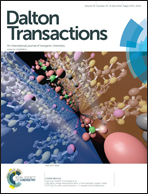Platinacycloalkane complexes containing [P,N] bidentate ligands: synthesis and decomposition studies†
Abstract
A new series of platinacyclopentanes (2a–2f) and platinacycloheptanes (3a–3f) of the type [Pt(N^P)(CH2)n] (n = 4, 6) were obtained by the reaction of [Pt(COD)(CH2)n] with the appropriate iminophosphine ligand (1a–1f). These complexes were characterised using a variety of spectroscopic and analytical techniques. X-ray structure analysis of complex 2a revealed a slightly distorted square planar geometry around platinum as a consequence of the ring strain imposed by the [P,N] chelate ring formed and the metallocycloalkane. Thermal decomposition analyses of the platinacycloalkanes revealed that the platinacyclopentanes are markedly stable, with the decomposition reaction requiring temperatures higher than 100 °C to occur. The major products obtained from the thermal decomposition reactions were 1-butene (for platinacyclopentanes) and 1-hexene (for platinacycloheptanes).
![Graphical abstract: Platinacycloalkane complexes containing [P,N] bidentate ligands: synthesis and decomposition studies](/en/Image/Get?imageInfo.ImageType=GA&imageInfo.ImageIdentifier.ManuscriptID=C3DT52798K&imageInfo.ImageIdentifier.Year=2014)

 Please wait while we load your content...
Please wait while we load your content...